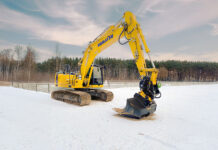
CDE has hailed the success of its recent two-day online symposium for the materials processing industry.
The virtual event, part of the firm’s Engineering Insights series, was designed to bring together industry professionals from around the world to debate a range of issues.
A number of presentations and panel discussions covered multiple sectors including sand and aggregates, construction and demolition waste recycling, industrial sands, mining, and wastewater.
Kiran Pereira, founder of SandStories.org, gave a talk on sand depletion in which she revealed that the world’s building stock is expected to double by 2060.
“We’re talking about massive, massive volumes here,” she said. “Sand and gravel today account for the largest volumes of solid material extracted globally.” Kiran added that demand is currently estimated to be about 50 billion tonnes per year.
Focusing on the recycling sector, CDE’s Eunan Kelly was joined by a panel of construction, demolition and excavation waste specialists to explore the challenges and opportunities associated with sustainable construction.
Scott Brewster, MD of Livingston-based Brewster Bros. Ltd, said, “There’s never been a time in history when the general public have been more informed about the environmental crisis we face.”
He explained how self-discipline and external pressures are leading a shift in how construction firms operate, stating that they have become ‘leaner and cleaner’ for their adoption of recycled aggregates.
Scott also believes political environmental targets and measures such as landfill tax and the aggregates levy will encourage more businesses to turn to recycled products.
Stephen Boyle, strategic programme manager at Zero Waste Scotland, emphasised the pressure that natural resources are under. He revealed that in 2018, Scotland generated 5.8 million tonnes of non-hazardous C&D waste and had a recycle rate of 97%.
Stephen said that while the industry has a good recycling rate, most recovered materials are being downgraded and that high-quality recovery and processing can make a difference.
“Good quality recovered materials lead to innovation and upcycling of material into the higher value products,” he stated.
Kenoteq has created the K-Briq, which is made from over 95% recycled content and has just one tenth of the embodied carbon of a traditional clay-fired brick. Dr Sam Chapman, MD at Kenoteq, said, “There seems to be a misconception that recycled waste materials are of a lesser quality and we want to add to the story that they’re absolutely not.”
Viv Russell of Longcliffe Quarries and James Thorne from the Institute of Quarrying explored the hidden value in by-product stockpiles. Viv said, “A lot of things have changed over the years. Certainly, overburden was something you would muck away… and potentially, in the life of a quarry, you would move around three or four times. You can’t afford to transport this material anymore.”
Viv added that the likes of scalping and crushed rock fines, which were once considered waste, are now seen as a resource.
Longcliffe had a bespoke wet processing plant developed by CDE, resulting in the recovery of high-quality single-sized aggregates and sand grades.
Viv added, “We’re an industrial minerals business using a very high grade calcium carbonate powders and fines…if any clay got into the material it would contaminate it. We were handling 300,000 tonnes a year. We were initially looking to do it (install a CDE plant) to create a construction stone material to sell into the ready-mix concrete market or general aggregates market. One of the things which we found, which we’re absolutely delighted about, is that because we managed to clean the material so well and remove the clays, it has actually…improved the stone chemistry so that we can use some of our industrial mineral products. That’s great from a sustainability point of view…and has opened us up to the decorative aggregates market.”
The symposium also featured a panel discussion on municipal and industrial wastewater separation challenges.
According to GEA, upstream wear protection is one of the main challenges it sees. The CDE ProDec plant was designed to protect its centrifuges. “In a process that is properly designed and managed, wear rates can be really low when you’re using centrifuges,” said Kevin Mooney, wastewater sector manager at CDE. He added that aggressive wear in wastewater processes doesn’t have to be accepted, but that the industry has become conditioned to view it as a normal part of the process.
Pat Condron, business manager, environmental, at GEA Mechanical Equipment, revealed that traction is being gained in terms of companies becoming more proactive and engaging in preventative maintenance.
In total, the two-day programme featured almost 90 sessions involving over 100 speakers. David Kinloch, director of business development UK & Ireland at CDE, commented, “In these unique and challenging times there are many restrictions that have prevented CDE, our customers, and others in materials processing from coming together at industry events to discuss the prevalent issues of the day and the latest technological advances.
“Utilising our global network, we decided to programme the major two-day Engineering Insights symposium which proved to be a huge success with almost 1,500 industry professionals from around the world registering. We firmly believe this shared approach to knowledge and expertise is a better way to aid the progression of the industry.”










